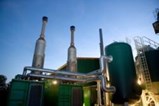Electricity From Grass, Manure, And Organic Waste: Evonik Setting Its Stakes On Eco-Friendly Biogas

Evonik uses renewable raw materials, organic waste, and manure to produce biogas, which it in turn converts into electricity and heat. Fermentation residue is turned into valuable fertilizer. The company has one plant in Karstädt, a city in the German state of Brandenburg, and additional plants are under construction or in the planning stage. Energy generation from biogas makes a key contribution to climate protection.
To make biogas flow, you need to have billions of "workers". The "workers" in this case are actually countless bacteria. They convert the biomaterial into methane, the fuel that powers the combined heat and power (CHP) plant of a biogas unit like the one Evonik Industries AG operates in Karstädt. Here, the biogas unit runs on manure and organic waste. From a neighboring dairy farm, the manure is piped underground to the unit. Road tankers and other trucks bring organic waste — such as frozen food products that have fallen out of the distribution chain, or residues from biodiesel production — to the facility. It takes enormous expertise to run a biogas plant. The bacteria require conditions that call for a certain composition of biomaterials. „Too much fat and alcohol aren‘t good for bacteria, either," says Christina Schumann, a chemical engineer employed at the biogas facility. If the bacteria are properly tended to, they work extremely hard. In just one hour, they produce 500 cubic meters of gas from manure and organic waste, which is all the facility‘s gas buffer tank can hold at one time.
The electricity produced by the CHP plant can power 2,000 homes, and a credit is issued for the electricity in accordance with Germany‘s Renewable Energy Law (EEG). Energy generation from gas must also be controlled. Methane combustion is really nothing new to the experts at Evonik, since the company and its predecessors have used mine gas, which also contains large quantities of methane. The heat generated by the CHP plant is used to power the biogas unit. A neighboring farmer picks up the fermentation residue and uses it as fertilizer.
Farmers operate many biogas plants, although their primary business is still their own farms. By contrast, Cord Cordes, a farmer from Kirchwalsede in Lower Saxony, places his stakes on cooperating with a partner from industry. Evonik and Cordes are working together to build a plant that produces electricity and heat from renewable energetic plants, manure, and dung. The electricity will be able to power 2,870 single-family households. The heat is used to dry the fermentation residue, which is pressed into pellets and used as fertilizer. With 430 pigs in his stalls, Cordes is certain: „I simply can‘t operate a facility of this size on the side anymore." The partnership benefits both sides by allowing the farmer to focus on producing energetic plants, manure, and dung to feed the biogas unit, while the industrial partner provides the technical and business expertise, as well as the knowledge needed to meet the requirements for official approval.
Also in Dorsten, a town in the northern Ruhr Valley, a farmer supplies the biomass on a project for feeding biogas into the natural gas network. More and more municipal utilities are offering not just eco-electricity, but environmentally friendly bio natural gas.
The use of renewable raw materials spares the environment enormous quantities of CO2. The burning of biogas emits only as much CO2 as the plants have taken in while growing. The organic waste generated in food production or trade, for example, is sent to facilities for useful recycling. "Biodegradable waste fermentation produces over 150 kilograms less CO2 per metric ton of waste than composting," says Prof. Frank Bauer of the Institute for Future Energy Systems. "The ability to use biogas more or less around the clock can make it an important component of distributed power systems," he explains. Biogas supplies continuous power and does not depend on certain weather conditions, as do wind turbine plants, for example.
To avoid competition with food production, operators can use grass cuttings from abandoned green spaces. Another option is to use energetic plants as intermediate crops. Evonik is also banking on dry fermentation, which allows for a larger share of dry materials, in the construction of its biogas units. Operation with dry fermented materials makes it possible to use all substances permitted at biogas facilities by law, such as mowed grass from the roadside or the contents of organic waste bins. Unlike wet fermentation, chicken manure can be used in this process, too. This is good news for the plant in Kirchwalsede—a community with an abundance of chicken manure.
SOURCE: Evonik Industries
